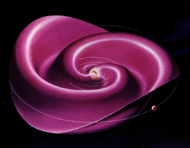Our website is made possible by displaying online advertisements to our visitors.
Please consider supporting us by disabling your ad blocker.
Sunspot
- Top: active region 2192 in 2014 containing the largest sunspot of solar cycle 24[1] and active region 1302 in September 2011.
- Middle: sunspot close-up in the visible spectrum (left) and another sunspot in UV, taken by the TRACE observatory.
- Bottom: a large group of sunspots stretching about 320,000 km (200,000 mi) across.
| Part of a series of articles about |
| Heliophysics |
|---|
 |
Sunspots are temporary spots on the Sun's surface that are darker than the surrounding area. They are one of the most recognizable Solar phenomena and despite the fact that they are mostly visible in the solar photosphere they usually affect the entire solar atmosphere. They are regions of reduced surface temperature caused by concentrations of magnetic flux that inhibit convection. Sunspots appear within active regions, usually in pairs of opposite magnetic polarity.[2] Their number varies according to the approximately 11-year solar cycle.
Individual sunspots or groups of sunspots may last anywhere from a few days to a few months, but eventually decay. Sunspots expand and contract as they move across the surface of the Sun, with diameters ranging from 16 km (10 mi)[3] to 160,000 km (100,000 mi).[4] Larger sunspots can be visible from Earth without the aid of a telescope.[5] They may travel at relative speeds, or proper motions, of a few hundred meters per second when they first emerge.
Indicating intense magnetic activity, sunspots accompany other active region phenomena such as coronal loops, prominences, and reconnection events. Most solar flares and coronal mass ejections originate in these magnetically active regions around visible sunspot groupings. Similar phenomena indirectly observed on stars other than the Sun are commonly called starspots, and both light and dark spots have been measured.[6]
- ^ "Gentle giant sunspot region 2192".
- ^ "Sunspots". NOAA. Retrieved 22 February 2013.
- ^ "How Are Magnetic Fields Related To Sunspots?". NASA. Retrieved 22 February 2013.
- ^ "Sun". HowStuffWorks. 22 April 2009. Retrieved 22 February 2013.
- ^ Mossman, J. E. (1989). "1989QJRAS..30...59M Page 60". Quarterly Journal of the Royal Astronomical Society. 30: 59. Bibcode:1989QJRAS..30...59M. Retrieved 27 June 2021.
- ^ Strassmeier, K. G. (10 June 1999). "Smallest KPNO Telescope Discovers Biggest Starspots (press release 990610)". University of Vienna. Archived from the original on 24 June 2010. Retrieved 20 February 2008.
starspots vary on the same (short) time scales as Sunspots do ... HD 12545 had a warm spot (350 K above photospheric temperature; the white area in the picture)
Previous Page Next Page







